
Spring flowers herald the gardening season and are a beautiful touch of color in living spaces in pots. There are many spring bloomers that are ideal for colorful springtime arrangements.
In a nutshell
- some spring flowers can be cultivated in the room
- Bulbous plants are well suited as underplanting in pots or troughs
- Plants such as crocus or wood anemone are an important source of food for insects in spring
Table of contents
- Spring flowers from A – G
- H – L
- N – P
- R – S
- T – W
- frequently asked Questions
Spring flowers from A – G
cyclamen (cyclamen coum)
Cyclamen are available in garden centers almost all year round. Only the cyclamen, which blooms in spring, is also suitable for outdoors and survives the winter with a light winter protection.

- Height: 5-10cm
- flower color: pink, white, pale violet
- heyday: February March
- planting time: Autumn
A notice: Other cyclamen varieties offered in spring are sensitive to frost. They are suitable as decoration only for frost-free interiors.
wood anemone (Anemone nemorosa)
The wood anemone is an important one food source for insects in the spring. The plant is completely absorbed over the summer and is an ideal companion in the pot for plants that only flower later.

- Height: 10-15cm
- flower color: white
- heyday: March April
- planting time: Late summer to fall
Sweet Violet (Viola odorata)
The original species of sweet violet is violet. In the meantime, however, there are numerous cultivars with different colors and larger flowers than the original species.
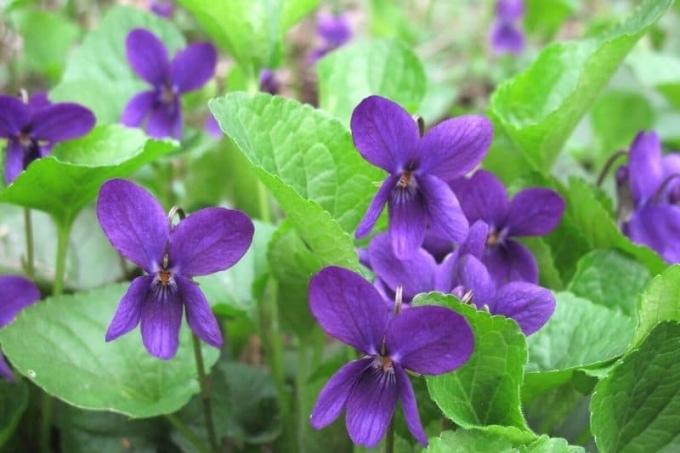
- Height: 5-15cm
- flower color: violet, white, pink
- heyday: March April
- planting time: spring or autumn
spring snowflake (Leucojum vernum)
The spring snowflake is often confused with the snowdrop. However, the spring snowflake opens its flowers much earlier.

- Height: 10-30cm
- flower color: white with green-yellow tips
- heyday: February - April
- planting time: Autumn
daisy (Bellis perennis)
The cultivated form of the daisy is also known as the daisy because it is a double variety. Despite the double flowers, they offer Insects still a food source.
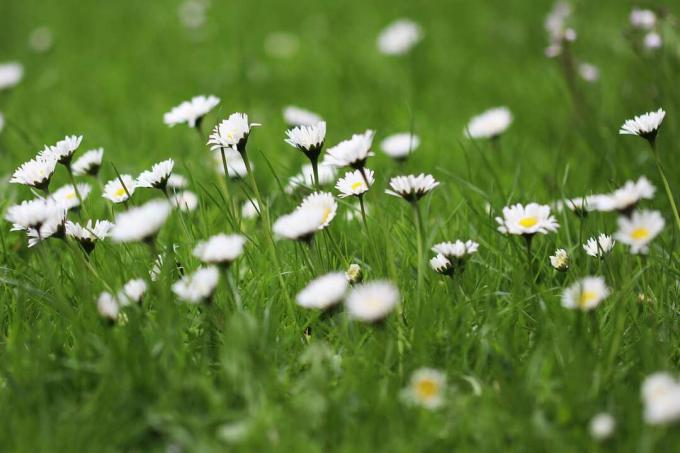
- Height: 5-20cm
- flower color: white, pink
- heyday: March – November
- planting time: flowering plants in early spring, non-flowering plants from late summer to autumn
H – L
hyacinth (Hyacinthus)
The hyacinth not only impresses with a lush inflorescence, but also with an intoxicating scent. It is frost-resistant, in a warm room flowering can be a few weeks earlier.

- Height: 15-30cm
- flower color: white, pink, violet, blue, reddish
- heyday: February - April
- planting time: Late summer to early winter (if the ground is frost-free)
A notice: Premature flowering costs the plants a lot of energy. It often takes several years for them to recover and flower again.
crocus (crocus)
There are many types of crocus that have very different colored flowers. The decorative forms are particularly popular with insects such as bumblebees in spring.

- Height: 8-15cm
- flower color: white, violet, yellow, blue, pink, multicolored
- heyday:February March
- planting time: Autumn
liverwort (Hepatica nobilis)
The liverwort is ideal for shady locations. Once the flowers are gone, it's still an attractive foliage plant on the balcony with interesting trilobed leaves.

- Height: 5-10cm
- flower color: predominantly purplish-blue, occasionally white or pink
- heyday: March April
- planting time: early autumn
spring rose (Hellebore)
In addition to the classic snow rose, there are several cultivated forms or introduced wild species. In addition to the white species, cultivated forms with dark, almost black flowers are particularly attractive.

- Height: 20-40cm
- flower color: white, pale pink, dark purple, red
- heyday: February - April
- planting time: Late autumn to early spring, whenever there is no frost
N – P
daffodil (narcissus)
Along with tulips and hyacinths, the daffodil is the most commonly planted spring flower. she is in the pot undemanding.

- Height: 5-60cm
- flower color: white, cream, light yellow, yellow, yolk yellow
- heyday: February - May
- planting time: Autumn
Web iris (Iris reticulata)
Web iris is a bulbous iris. It is partially frost-resistant and needs some protection in winter.

- Height: 10-15cm
- flower color: different shades of blue, white, violet, cream
- heyday: February March
- planting time: early autumn
slipper flower (Calceolaria)
The slipper flower is a popular ornamental plant in spring, but it is not frost-resistant. It can be cultivated indoors in a pot with a medium effort and can be outdoors in summer.

- Height: 30-60cm
- flower color: yellow, orange, often with speckles
- heyday: April - September
- planting time: frost-free all year round
primrose (Primula)
The primrose is the most species-rich group among the spring flowers. In addition to many wild forms, there are numerous cultivated varieties that are characterized by a varied range of colors and large flowers.

- Height: 5-25cm
- flower color: white, yellow, orange, pink, red, violet, blue, multicolored
- heyday: February - May
- planting time: spring
A notice: Plants in pots that are indoors should have as cool and bright a place as possible. After a period of getting used to, they can later be placed outdoors.
R – S
ranunculus (Ranunculus asiaticus)
Ranunculus originally comes from Asia and is only partially frost-resistant here. They can be overwintered cool and frost-free in a greenhouse.

- Height: 20-40cm
- flower color: white, yellow, pink, red, orange
- heyday:April June
- planting time: spring
snowdrop (Galanthus)
There are around 20 different species of snowdrop. The decorative bulbous plant is suitable as an underplanting for perennial plants that flower later.
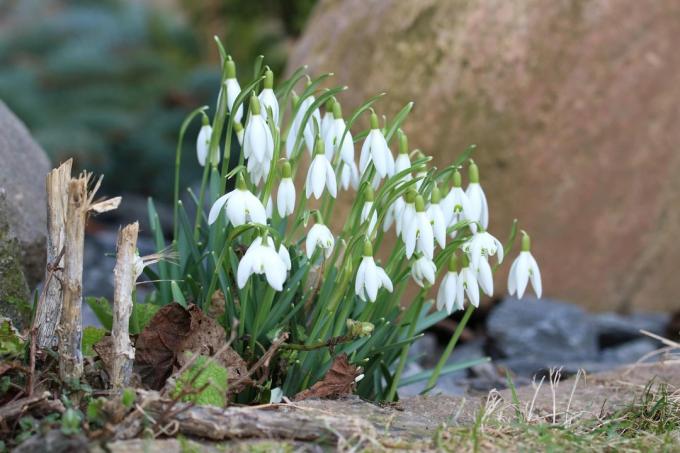
- Height: 2 - 18 cm
- flower color: white
- heyday: January February
- planting time: Autumn
pansies (Viola tricolor)
The pansy is closely related to the sweet violet. Regular pruning of faded flowers can extend the flowering period well into summer.

- Height: 10-20cm
- flower color: white, pink, blue, violet, orange, yellow, multicolored
- heyday: March – October
- planting time: early spring, autumn
T – W
tulip (tulipa)
There are now more than 5,000 different varieties of tulips.
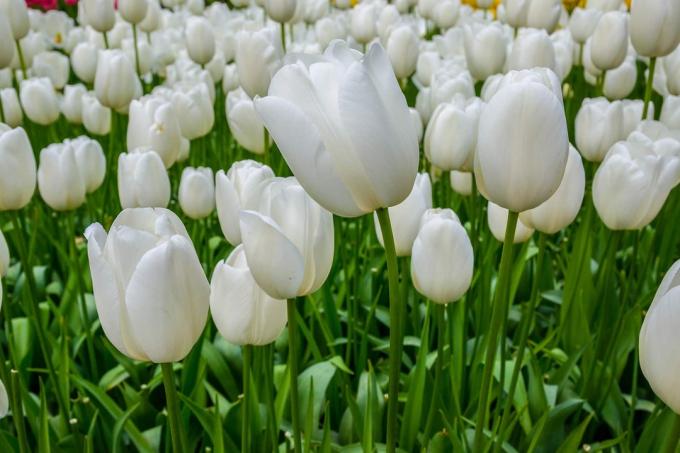
- Height: 10-20cm
- flower color: white, pink, red, violet, orange, yellow, multicolored
- heyday: March May
- planting time: Autumn
Turkish poppy (Oriental Papaver)
The Turkish poppy is conditionally frost-resistant. In the pot, it should be overwintered frost-free so that the roots are not damaged.

- Height: 20-100cm
- flower color: red
- heyday: April June
- planting time: spring
forget Me Not (myosotis)
There are many wild and cultivated forms of the forget-me-not, which are characterized above all by their varied inflorescences. In addition to dense flower clusters, there are also varieties where only a few flowers are enthroned on the tips of the shoots.

- Height: 20-40cm
- flower color: light blue, white, pink
- heyday: March May
- planting time: autumn, flowering plants in spring
winterling (Eranthis hyemalis)
Winterling is one of the first flowers in spring. In the pot culture, it is often not very easy, as it is completely absorbed and then people forget to water it.
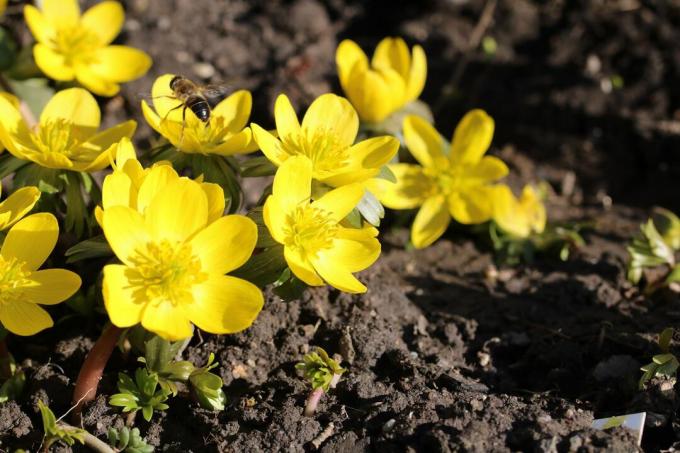
- Height: 5-20cm
- flower color: yellow
- heyday: February March
- planting time: Autumn
Tip: The winterling has no bulbs as outlasting organs. So that it does not dry out, it should always be combined in the pot with other plants that are green over the summer.
frequently asked Questions
When cultivating in pots, it is important to protect the root system in winter. For example, overwintering in an unheated greenhouse is ideal. Alternatively, you can pack the root ball thickly with jute. On the surface, hardy spring flowers usually do not need protection. Cover them with twigs, the twigs should be removed in early spring so that flowering is not delayed.
Perennial spring bloomers in particular should be repotted in early spring or at least given basic fertilization. This promotes the formation of strong shoots. Don't just fertilize with nitrogen, but also give the plants a potash fertilizer that favors the formation of flowers. However, it is normal for the spring flowers to bloom a little weaker the following year after a year with many flowers.
Spring flowers are often commercially available in very small pots. Bulb flowers such as tulips or daffodils in particular are often not properly covered with soil. This amount of soil is not enough for a permanent pot culture. As with other flowers, there should be at least a hand's breadth from the edge of the pot so that the plants can still develop in width. To do this, pot them Just transplant into a larger pot.
